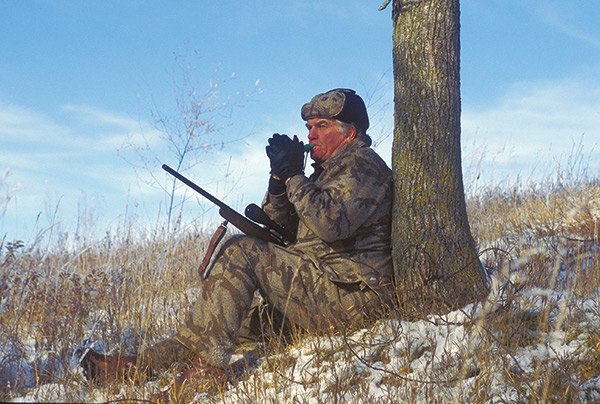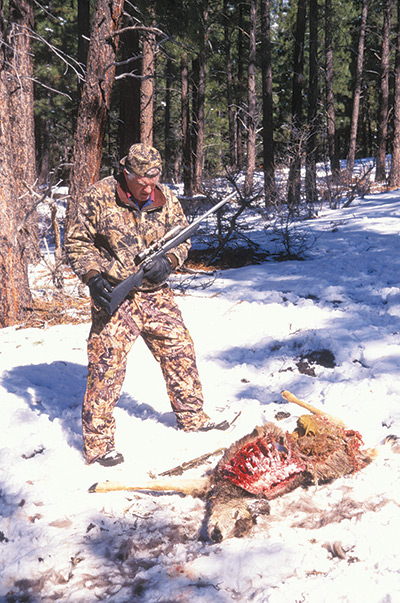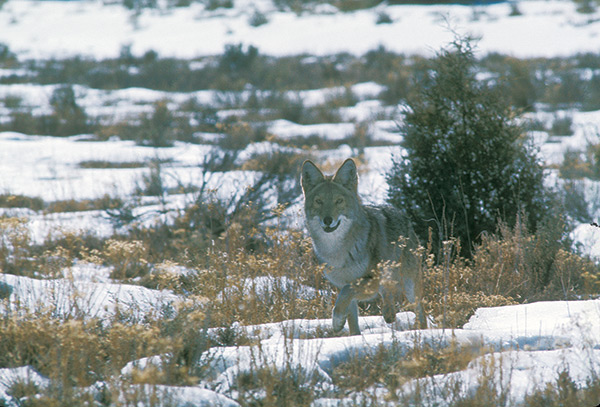 Predator Hunting: Baits and Calling and Snares
Predator Hunting: Baits and Calling and Snares
By Judd Cooney

The 30X scope showed the big dog coyote bedded next to the cow skull attractor on the ridgetop flat set, half mile off the road, his front foot held firmly in the No. 3 coil spring. A second coyote was hanging motionless in a snare, 50 yards up the ridge, along a well-used trail that exited the dense oak brush there. I’d hung the snare on that trail a week earlier. Both trapped coyotes were completely ignored by the lone canine voraciously gorging itself on an already savaged steer carcass I’d carefully situated there the previous week.
I eased my truck a quarter mile up the road and out of sight, behind a sagebrush covered ridge, grabbed my newly acquired Bushmaster .223 AR rifle and started my stalk. My stalk was a no-brainer, from a totally unobservable route, with a favorable prevailing wind. The whole location was half a mile from a gravel road and not likely to be spotted by even an observant driver unless he used binoculars and a spotting scope or was a predator hunter sharp enough to interpret eagle or raven activity.
I slipped to the last vestige of cover, then crawled the last 30 yards to a couple clumps of sagebrush I’d moved into position to make an effective blind, fully breaking any human outline or movement while providing a solid shooting rest. The coyote, 200 yards out, was still tugging and tearing at the carcass when I settled the crosshairs on his chest and permanently ended his predations.
Later that week, a foot of wet snow and freezing weather decommissioned my traps. But after the storm relented, I again spotted a coyote on the carcass, and one hung in a snare 100 yards from the bait. When I got to my ambush blind, the feeding coyote had disappeared. However, a key element to successful predator calling is to be within hearing distance of the predator you’re trying to con. So, I knew that canine was well within calling range when I filled the still mountain air with coarse jackrabbit squalls from a raspy new Thomas mouth call.
Within a couple minutes the lone coyote came running out of the brush above and behind the carcass. When it paused a few yards from the bait, the 52 grain .22-250 Sierra hollow point boattail flattened it where it stood.
I considered that a pretty good start on predator hunting in a single location: two snared coyotes, one trapped; and two shot, one off the bait, a fifth conned with a predator call.
By the time the fur season was done with that year I’d snared five coyotes, shot four off the carcass, trapped one and called in another single for a total of 12 prime pelts added to my fur shed.
At the time, fur prices were peak, and I’d become involved in buying furs on a regular route in Colorado. These were furs brought in by hunters and trappers from Colorado, New Mexico and Utah. I was very surprised predator hunters collected most of their pelts by calling only. Very few used baits. Also, very few trappers snared predators. And almost no one combined all these effective methods.
The trappers, by far, had the best-handled pelts. Consequently, they got the best prices. The shooters and callers would commonly bring in unskinned carcasses with bullet damage or skinned and poorly handled pelts only worth half as much as a properly handled fur. However, there were three times as many shooters whose predator hunting was a haphazard venture, compared to the hard-core proficient trappers.
My experiences outfitting for trophy spring bear hunts had taught me the value of proper implementation and planning when using bait to hunt predators. And this, over the years, added many opportunities and prime pelts to my adventures.

Predator baits can range from a 1,000-pound steer carcass down to boxes of frozen meat scraps from a meat processing operation. For years, I had a walk-in freezer on a trailer and bought 70-pound boxes of frozen scraps for $2 a box for bear and predator bait. I also had an advertisement in the paper to pick up any dead livestock. (Make sure you advertise for reasonably fresh critters, so you don’t end up with a green, 1,000-pound horse carcass in the bed of your pickup that your daughter just might drive to school and park by the gym. Not good public relations.)
Choosing the bait site is critically important. Some places, you can scout out the site and choose a somewhat hidden location where you can glass the bait from a distant location and stalk any critter utilizing it. Other locations are prime predator habitat where using bait might be limited to traps, snares or sneaking into the site once it is being hit, and calling. Calling near a hammered bait can be very effective. Predators can get very possessive of their free lunch counter.
If you utilize public land, check with the proper wildlife agency for any necessary permits and regulations for using road-killed critters for predator bait. You can keep bait on the site year-round if you have a surplus. It makes it better. Every predator in the vicinity will check it out.
Many baits I’ve had were accessible only by snowmobile once winter set in. However, I had a small Tucker Sno-Cat that would go over any depth of snow and tow a horse or cow carcass with ease. In that situation, I laid out my approach with the snow machine trail angling in front of my ambush hide. An escaping predator will be more inclined, in the confusion, with the snap of a bullet overhead and the echoing shot, to take off on a packed trail and avoid soft snow. I’ve killed second and third critters on numerous occasions within spitting distance of the blind after taking the most distant predator first.
Another key factor using bait is visibility. On one occasion, I towed a 1,500-pound coal black draft horse carcass to a bait site with the Sno-Cat. During the next week we got snow that completely covered the carcass and for the following week there wasn’t a critter track anywhere near the frozen horse.
I normally wait until predators hit the bait a few times before setting snares to better pinpoint trails leading to and from the carcass. I try to place the snares at least 50 yards from bait, to keep a snared coyote from spooking those around the bait.
I once snowmobiled into a horse carcass bait and scooped all the snow off it. The next day, 20 ravens and four eagles were feeding on the carcass – just the advertising I needed – because three days later I shot two coyotes there and set half dozen snares. Over the course of the winter, I snared six coyotes and shot five more, one coyote sitting 20 yards from my brush blind trying to figure out what ruckus caused his buddy to spin around on the hillside above the carcass.
Over the high-fur price years, I trapped, bought fur full time, and usually had anywhere from six to 10 baits scattered from Wolf Creek Pass to the New Mexico line and 60 miles west toward Durango. I averaged 10 coyotes per bait for several years, with my best day being 15, five with rifle, four stalking, one calling, ten in snares and one snared 30-pound bobcat as a bonus.
Once your site has proven itself by providing opportunities, it gets better each season. It will take some good relations with a landowner, but generally getting predator hunting permission isn’t that difficult.
Combining methods works. Anyone limiting their predator chasing ventures to one method is missing some real challenges and the chance to put more prime pelts in their collection.
